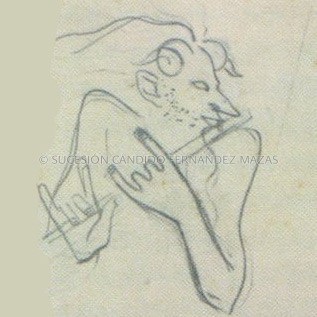For little Daniel,
drawing light eyes breasts
Sin voluntad de clasificar ni de limitar su compleja personalidad intelectual y artística, sino con la intención de situar esta en el contexto histórico y en el campo cultural que le son propios, es preciso hacer explicitas las coordenadas en las que se movió el escritor Cándido Fernández Mazas, en especial por aplicación de una perspectiva sociológico-cultural que ofrezca un plano mínimo de referencias y de tomas de posición, tanto de las compartidas como de las individuales. Tal plano tendría alguna validez si fuese capaz de informarnos, por ejemplo, de qué supusieron las propuestas del autor en relación con la tradición inmediata y con las líneas dominantes en la producción literaria del momento, tanto en el horizonte español como en el gallego. Al lado de quién se situó y frente a qué tipo de actitudes e intervenciones operó?
Like many artists of his time, Fernández Mazas was a multiple artist, both plastic and literary dimension. Quantitatively dominates the dramatic latter sector, which will not deal here only tangentially so1But we must also have a critical-essayist and polemicist vocation2With the prints and (narrative descriptive) fragments3 and a dedication to poetry that could be described as testimonial. This territory is the last in which predominates the Galician language, although there is anecdotal attempt automatic writing in French and a small group of poems in Castilian4. Moreover, various testimonies to contrast difficult at this point, talk about the existence of loss and projected construction work, certainly without effective implementation. Rafael Dieste mentioned in the preface to volume Santa Margori *, The crazy hornsThe draft of a book of poems -Aleteia- he had also referred Augusto M. Casas in the famous "Outline da nova Galician poetry" published in the latest issue of We (1935). And Torrente Ballester recalled that "a Sunday afternoon [1930] read us, some friends, a comedy in Galician, two who had"5
There is a point of considerable interest Torrente used in this text, which portrays the gathering together of La Granja "The Hayfield" in the early thirties. This Madrid cafe was the meeting place I have been calling the "group P.A.N."Precisely to constitute this magazine that ran Otero Espasandín and was sponsoring Eduardo Dieste one of the most remarkable achievements of six years of coexistence, debate and public involvement of a relatively cohesive writers and artists nucleus, most of them Galicians, based in Madrid from the Republican aurora (Casas 1997: 261-347). One of its decisions group greater sociocultural significance was the enthusiastic participation in the Pedagogical Missions planned and directed by Manuel B. Cossio. As part of the Missions, the Guignol Theater was a company that belonged almost entirely to the self panidasCoordinated by Rafael Dieste. But back to the note of Torrente, very defining in relation to intellectual paths Mazas and the people closest to him. Says so:
He spoke of his literature as his painting: as a bunch of problems rather than solutions. He had been in Paris; the avant-garde did not satisfy him just like that, like solutions, but had left their planted spirit of problems (ibid)
Such spiritual or intellectual situation, and the correlative attitude are important, indeed, to understand the environment in which creative and critical activity group who were mentors Eduardo and Rafael Dieste brothers and involving developed also Otero aforementioned Espasandín, Eugenio F. Granell, Alberto Fernández Mosque, Antonio Sánchez Barbudo, Enrique Fernández Sendón (heels) And Jesus Bal and Gay; less permanent or more links later Carmen Muñoz, Lorenzo Varela, Antonio Baltar, María Zambrano, Roberto Blanco Torres, Ramón Gaya, Carlos Gurméndez, Arturo Souto, Carlos Maside and Urban Lugrís. Beside these payrolls, should make mention of magisteria expressly recognized in the pages of P.A.N.Primarily because they help plan drawn a concordance etoestéticas. The names are now Unamuno, Antonio Machado, Valle-Inclan, Cossio and Azana. In the intellectual field, and to some extent also in the vital area, they are the most outstanding references.
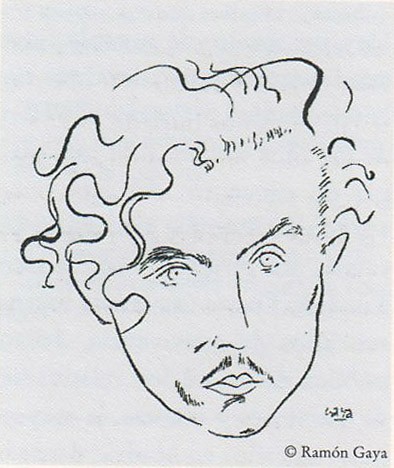
Portrait of Antonio Sánchez Barbudo by Ramón Gaya in School WorkNo. 19-20 (September-October 1933)
The greatest of Dieste, Eduardo, diplomat and writer born in Uruguay in 1882, repeatedly referred to a provision of problematical spirit in their books on aesthetics, especially in Teseo. Literary problems (Montevideo 1938) and Teseo. The problems of art (Buenos Aires, 1940). In line with this myself, I have argued that one of the peculiarities of the group P.A.N. -diríase that Mazas- was clearly applicable to their propensity to problematizador think, even a aporetics bias and criticism, not covered by ideological or artistic coordinates of the considered trend the schoolAnd that from the epistemological perspective owes much to Kant on the fundamentals and Husserlian phenomenology in attitudes.
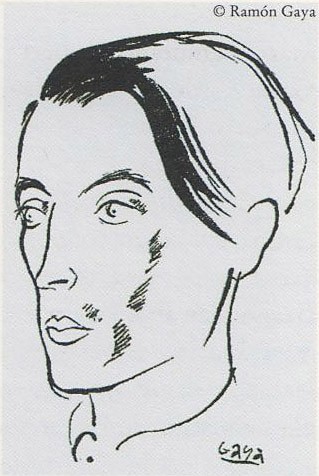
Portrait of Rafael Dieste by Ramón Gaya in School WorkNo. 19-20 (September-October 1933)
Speaking of Mazas, this same feature can be seen in the political arena, even considered the specificity derived from its collaboration with the P.O.U.M. -party Trotskyist founded in September 1935, which had entered the other three Fernández Group: Granell, Mosque and heels, The latter coming as himself Andreu Nin, Communist or Left little fluid relations with the Orthodox Galician nationalism, with whom she had more than a frontal encounter in the thirties and, in key aesthetic and sociological cultural and distanced it in that kind of manifesto is "a line in the Galician culture" text published in September 1929 during the brief journey of Gaceta de Galicia.6 Vicente Risco the ideologue and chief strategist galleguismo during the twenties, certainly classify the author Santa MargoríTogether with Rafael Dieste, in the field of hypercritics, refiriéndose con esta etiqueta a algo más que a un inconformismo teórico o vital. Con todo hay un aspecto que singulariza a Mazas en relación con sus compañeros de grupo: su vocación polemizadora y sus discrepancias tuvieron a menudo una formulación tensa, contundente en las formas y en el fondo, nada conciliadora. José Manuel Bouzas (1998: 307) ha expuesto lo siguiente:
La dificultad de subsistencia como artista es mucho más difícil para alguien que, como Cándido, es incapaz de someterse a nada ni a nadie por un logro; de una capacidad dialéctica forjada en la propia autoexigencia y ascesis intelectual –temible incluso para sus compañeros curtidos en el debate– , de una violencia verbal y un sarcasmo hiriente que podía llegar a la crueldad. Tal era su ansia de perfección y de pureza.
Esto sorprenderá, acaso, a quien sólo conozca al dibujante o al pintor de sensibilidad más lírica y sosegada (al de la serie de dibujos parisinos por ejemplo), aun teniendo en consideración la última de las frases de Bouzas que se citan, por la cual quedan interconectadas la voluntad ascética y la aspiración a la pureza con un rigor dialéctico aristado en la disciplina del método y en unos insobornables principios éticos. Carlos Gurméndez (1981: 7-29) ofrece algunas otras pistas sobre los posibles motivos últimos de esta inclinación que sería empobrecedor entender como un mero gesture or as one among the envidentes psychic imbalances artist, a person of "Dionysian vocation" according to Dieste points in his "Introduction" to Santa Margorí, Borrowing the label Mazas- itself, but constantly on the verge of strange anguish that suddenly transformed his cheerful mood, so splendidly dialogal and friendly, in an underdog or fantastically suspicious "(V) being. Gurméndez also comes to human relationships Mazas, more specifically to erotic and emotional, to discuss your deepest conflicts. Love for Margarita Xirgu and other actresses, relations with an aristocrat or a naive creature ... Strong conceptual plasticity describes the mood friend: he speaks of a angelism love and of dramatic contradictions Mazas tried to explain it by reference to intellectual love Spinoza. Hence also appeal to children as unrecoverable intransitive paradise of purity and beauty, threatened by dark dangers. And in this regard we must consider the peculiar recurrence of intersecting myths in his work, the Don Juan and Barb Blue, often themselves deceived or disappointed, indecisive or timid, in a confusing process reversal or at least demystification in Spanish literature of the first third of the twentieth century has varied proposals (Grau, Valle-Inclan, Marañón, Pérez de Ayala, the Machado, Azorín, Jardiel Poncela ....)7
En el fondo de algunas de las cuestiones vistas latiría la difícil convergencia entre el materialismo dialéctico y el esencialismo idealista, o entre Historia y eternalismo utópico, o entre la realidad efímera y el deseo de trascendencia; mucho más acuciante en un pensador y creador cuyos presupuestos éticos y estéticos –nueva coincidencia con Rafael Dieste, acaso por referencia común a Max Scheler ya Marjan Paszkiewicz– estaban inscritos en un sistema axiológico, en un marco de valores constituido, elaborado y asumido como resultante de un largo y complejo proceso íntimo, parece que en la orilla misma de la angustia existencial. Todas estas tribulaciones tenían que sustanciarse con intensidad en alguien que próximo al trotskismo, propendía de modo irreprimible al esoterismo ya las diversas neosofías de la hora, a veces en el límite del misticismo y el orfismo;8 someone who was attracted by the political satire and time by neopopularista lyricism, by the Lenormand psychoanalytical theater and Plato, for Balzac and both by Ibsen.
In any case, as we read in the writings of Armando Fernández Mazas and contrast it with other sources, the personality of Cándido used to transmit very remarkable security and resolution. It would seem that his intellectual and vital confusions distils finally self-confidence, both n the creative act and the critical exercise.
****
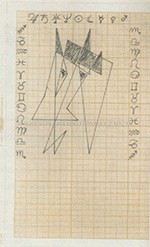
Cándido Fernández is likely to experience similar Mazas and intellectual upheavals in the past decade, for example during their vigueses years when narrowing circle with the important group of intellectuals participating in the project The Pueblo Gallego, Liberal-leaning newspaper that in 1927 became the property of Manuel Portela Valladares and from 1924 had taken over from his predecessor Galicia, Heavily guarded by primorriverista censorship. Culturalist in their galleguismo, progressive, federalist and filosocialista moments, The Pueblo Gallego fue ante todo un medio pluralista y no excluyente. En sus páginas publicaron autores tan dispares como Indalecio Prieto, Vicente Risco, Pérez de Ayala, Andrenio, Largo Caballero, Castelao, Francisco L. Bernárdez, Ramón Gómez de la Serna, Víctor Casas, Azorín, los hermanos Villar Ponte o Wenceslao Fernández Florez. Otero Pedrayo recordaba a este respecto que en la puerta del despacho del director figuraba un cartel con la leyenda “Esta es la avenida de la libertad. Aquí puede escribir todo el mundo”. Entre los redactores e ilustradores de la plantilla, al lado de Mazas, hubo nombres de la talla de Rafael Dieste, Amado Villar, Carlos Maside, Eugenio Montes, Roberto Blanco Torres, Felipe Fernández Armesto, Luis Amado Carballo o Evaristo Correa Calderón. En el ideario de la redacción, publicado en el número del 1 de enero de 1926, se leían frases como esta: “Sabemos que un periódico es tanto más alto y frondoso cuantas más hondas raíces tenga en el alma popular”; o esta otra referida al grupo de redactores: “Somos profundamente diversos y no obstante, o quizá gracias a eso, nuestras voluntades forman el más armonioso y firme ensamblaje”9.

Mazas also had participation in other journalistic and sociocultural intervention projects. For example, those related to self Galicia, Or the agrarista The Zarpa, Where he met Roberto Blanco Torres, Jacinto Santiago and Manuel Lustres Rivas. Also with AlfarHere the hand of Luis Huici10Or already in very lesser extent We. Se evidencia en esta nómina una cierta heterogeneidad en las tendencias ideológica y estética, también presente en el núcleo Ourensano de amistades en el que Mazas creció alrededor de sus veinte años: al lado de Eugenio Montes, Álvaro de las Casas, Manuel Cid, Xavier Bóveda, Francisco L. Bernárdez, Manolo Méndez o Madriñán Neira (A.Fernández Mazas, 1992; Bouzas 1998).
El conjunto de las aportaciones relevantes de la preguerra gallega en el ámbito del pensamiento estético es más diversa de lo que comúnmente se reconoce (Casas, 2000). Correspondió al nacionalismo ligado a las Irmandades da Fala la activación de los debates sobre las limitaciones de la pintura regionalista a partir de 1916. Los recorridos ideológicos de Castelao y Risco a lo largo del segundo y tercer decenios del siglo XX representan en cifra biográfica e intelectual un proceso que entre otros frutos deparó el ambiente idóneo para la consolidación del Movimiento Renovador de la plástica gallega y una recepción bastante crítica de los textos doctrinales y de los productos artísticos salidos de las factorías de las vanguardias históricas europeas. La convergencia de Risco y Castelao tenía en sí misma algo de inexplicable, y pese a abarcar varias esferas no duró demasiado. Bajo la perspectiva histórica, la empresa del “Grupo Nós” en el terreno estético se revela marcada aún por algunas pautas ilustradas, pero sometidas al etnicismo orgánico-historicista de Ovidio Murguía y matizadas por el espíritu de la investigación cultural propio del “Seminariode Estudos Galegos”.
Somewhat oversimplified talking sometimes opposition between the conservative nationalist thought of "Nós Group" and a tendency universalist O non-anthropological representada cuando menos por dos líneas actuantes a partir de los primeros años veinte. Una de ellas sería la inciada por Alfar and continued into chapters like Estela, con referencias claras al ultraísmo y receptiva en general a los lenguajes de las vanguardias (incuso con una tardía manifestación surrealista). La otra sería la que aspiró a establecer unas bases sistemáticas de relativa abstracción conceptual para el pensamiento estético y teórico gallego, con influencias de Dilthey, Croce, Scheler, D’Ors, Ortega y la fenomenología, incluso de Heidegger o del materialismo histórico y el marxismo a partir de cierta altura. La dinñamica entre esas orientaciones es demasiado compleja para detenernos ante ella, pero debería bastar la consideración de trayectorias como las de Xoán V.Viqueira, Álvaro de las Casas, Rafael Dieste, Eugenio Montes, Francisco Miguel o el propio Fernández Mazas para convencernos de la existencia de zonas de convergencia y de (con)fusión de horizontes en absoluto despreciables.
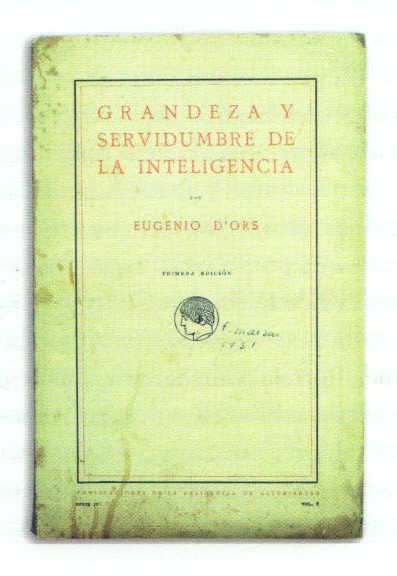
Some of the most important contributions of aesthetic thought interwar Galicia are extremely diaphanous in the statement of the theoretical sources nutricias. The more, with probability, Aesthetic muiñeira (1923) Eugenio Montes, where allusions to Feijoo, Goethe, Vossler, to Worringer, D'Ors to, to succeed But Cocteau ... interested referring in particular to the Renewal Movement -the new ones- which has its main theoretical and critical Dieste. For the new ones el cometido primordial fue la determinación de Galicia en cuanto categoría estética integradora de un sistema de valores capacitado para revelar, además de un orden sensitivo-sentimental y antropológico, una entidad ontológica. Maside fue de todo aquel grupo de artistas plásticos el más cartesiano, pero todos los componentes del grupo –en general poco dados a la teorización– evidenciaron sed de experimentación técnica y apertura reflexiva a las corrientes de vanguardia, en un proceso que partió del conocimiento de las obras de Cézanne, Picasso y Matisse, también de los textos teóricos de Kandisnky, pero que enseguida se diversificó para atender distintas tendencias del expresionismo (sobre todo en el primer Maside, en Souto y en Laxeiro), Cubism, Surrealism, and the Italian metaphysical painting. To the ontological furor beating on plastic group's proposals would still add a predisposition toward transpintura, Understood as the result of an aesthetic vocation krausista, which were also receptive Viqueira, the Dieste and Fernández Mazas brothers.
The theoretical approach of Maside and Rafael Dieste with regard to the aesthetic realm is more than remarkable, but the first left little written theorizing. Both shared a, suitable for equally significant phenomenological method trait Viqueira and Mazas from the early twenties, regionalist spirit in our author is likely to direct reading Ortega, rather than the influence of Montes (A. Fernández Mazas, 1992 : 16). Maside and Dieste agreed view thing as a unit, total, indivisible mysteryNot accessible through the Kantian record the sum of qualities, prints or categories. His effort directed therefore to communicate (are) directly (with) deep unit object as integrity, never with ordered data structure. As in Heidegger and Hartmann, the unveiling of the thing-his appear- not meant for them the disappearance of the mystery. This key helps to understand the rapid spread in Galicia had since the late twenties, the ideas of Franz Roh on magical realism, current to which at different times of the prewar referred, albeit without enthusiasm, both Maside as Dieste, Seoane, Mazas or Cunqueiro.
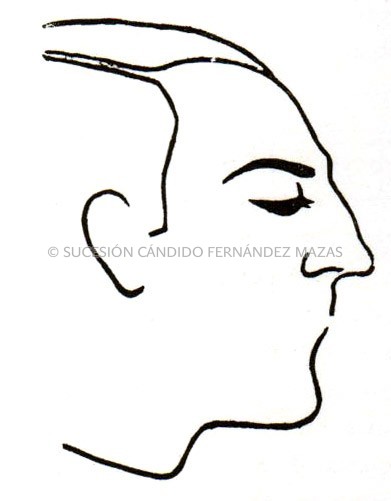
Rafael Dieste Galicia represents the most prominent building effort under an aesthetic system. Such a system had on him rigorous phenomenological foundations, axiológica or estimate methodology Scheler and Crocean base and, finally, epistemological horizons etopolíticos linked in the beginning with the empathy and the neokantismo after the ratiovitalism of Ortega y Gasset, to evolve in the years of the Second Republic and in exile towards elucidadora hermeneutics of conflict, myths, historical reality and communicative or dramatic reason.
None of this is foreign to the aesthetic thought of Cándido Fernández Mazas, whom Dieste (1940) saw himself as plastic creator of Latin-metaphysical trend. Like other intellectuals and artists of the moment, Mazas showed no interest in systematically formulate their theoretical convictions. This demands of us a kind of reconstruction on the basis of the evidence that the author left in contributions several critical task is somewhat simpler from the publication of volumes compilatorios Fernández Mazas journalism11 (1990), care Armando Fernández Mazas, and Cándido Fernández Mazas. His life and work (1981) of Carlos Gurméndez, who told for editing with the help of that. We will do only two or three coves that allow us to establish a minimum mapping.
It is significant to start with which the distance from the pages of P.A.N. He watched the course of the historical vanguards. Mazas, who was the art critic official magazine, as well as its most frequent illustrator, read in 1935 surrealism as a weightless art and comforting, become, like Cubism, in the goods to which gallery owners and bourgeoisie had allocated the bulk of their investments in painting (P.A.N., 2: 22). Just that. What could have happened between the year 1922 he had written "The man with the stick" surreal imprint also present at the opening prosas "Cinema & Dimanche" (a few years later and described in the book Drawings Paris), And this complaint 1935? Perhaps, in essence, the finding of an insoluble incompatibiliad between the attitude taint of self-absorbed, intimate, puerile and ahistorical first surrealism and experienced materialistic opening following the entry into the Communist Party of the most prominent members of the movement . Place in historic figure intimacy of consciousness, excising the world of ucronía to temporalizarla, was in his eyes a simple paralyzing impasse. The reasoning is symptomatic of own developments and contradictions, more alláde what q want to be on it the iconoclast Mazas, not only critical of what appeared as traps and blandishments of post-impressionism, magical realism, expressionism ... -and with the works of Rousseau, Modigliani, Chagall, Solana ... - but hard even in trials relating to certain times of the journey creator of El Greco, Goya and Velázquez.
But the first significant text and to what extent is already- "The new art and Manolo Mendez", first published in the newspaper Galicia and collected in Journalism Fernández Mazas (Pp.107-110), where it is dated to 1923-1924. Reading leaves no doubt about the important early traces of phenomenological thought in Mazas, it manifested in as accurate as that pinpoints this Ortegan figures phrase: "Inventing is merely a finding things." The axis of reflection is critical here the modern concept of trueWhich both philosophy and science of the day had helped anachronistic undressing brands such as uniqueness, universality, immutability and timelessness. This concept true, You have to declare in advance, it is crucial for understanding the work and literary and plastic Mazas even his idea of what the reality he goeth. He himself gives antender that his conception of the ontological truth and reality goes pro playful aesthetic filters necessary formulation (again, it is evident the influence of Ortega). But more important than this is his assumption of art as epojé.

Photography of Manolo Mendez appeared in the newspaper The Pueblo Gallego (July 25)
In Husserl, the epojé is a throw back to look. A result of its implementation is that it dispenses with something (hence the usual reduction). Thus, in the epojé without something besides also retains something positive, what is essential: the essential. Therein lies precisely eidetic reduction, which is aimed at eidos, The pure essence.12 Read in that light the following paragraph of the essay "The new art and Manolo Mendez" which-should insist- is one of the oldest among the preserved Mazas:
Once you found the noúmeno parte el artista hacia la síntesis. De la complejidad de su “no-yo” retira, como elemento amórfico, todo lo que de anecdótico tienen las cosas. Selecciona, pues, el pintor sintético, hacia lo universal. De un gasómetro recoge la medida y la armonía que refleja de todos los gasómetros de su especie. –¡Qué maravilloso sería el pintor que nos diera la síntesis de aquel pobre farol sentimental […] Yo colocaría un bello jarrón en la guerrera atalaya del arte nuevo: “No pintéis la fisonomía de las cosas, una estética no se hace con anécdotas, sino con categorías” (pp.109-110)
Here are some of the defining principles of the work of Fernández Mazas and its phenomenological aesthetics. For example, the paramount option for the synthesis, the last of his abandonment of volume and complaint about the phobia empty space, according to him, characterized the Galician painting of the moment (ballasted ethnography, say elsewhere) key. Empty / silence, so important in his concept of artistic work. It is also reflected in the aforementioned article essentialist orientation away from processes novelization, Regardless of any theme-anecdotal taxation. In printmaking, essentialism determined in a waiver of the depiction of facial features and preference for contemplation from behindFleeing from the face and the concreteness of detail. In the literary field appearing similar marks.
That prefer the abstract noumenal to the phenomenal, or in other words the intelligible to the sensible sign forever the pace of categories ordering his poetic word and even theater concept, understood in the literary-dramatic sense and also in that of show. This also departed from folletón and naturalism; Here too it was a Greek. In the theatrical, or operated Mazas in a way that does not deviate too much from implemented by those in interwar Europe favored recoveries of visuality, mask and splits or puppet, often served by the high pragmatic argument for performance and economy myths. Sometimes even against history, against the historical definition of the characters (as in The crazy horns, in the legend of Don Juan or An unfinished novel), But certainly not out of history, a sort of mundi escape. It is important to note in this regard the subversive charge, the political dimension of works such as those just referred, to which can be added without difficulty Santa Margorí.13 So I think that it would be inappropriate to classify the theater Fernández Mazas with such paradoxical sign as Farce categories, Which has the added virtue of minorar without suspenderlas- certain expressionistic and surrealistic brands last -these just in Santa Margorí- that seep into the theater concept background, including recursion of the unfolding and the consequences for the (id) entity and the fragility of the characters, the delight in costume and even in a travesty of metamorphic magnitude alternatives the principle of causality or, anyway. The dissolution of personality and world in the margins of sleep, imposture, division, of uncertainty, of alienation.
A second station in which it should stop and belongs to the stage P.A.N. Se abre en concreto en el número 3, de marzo de 1935. Allí publica el ensayo “De los valores vitales artísticos y de su seguimiento” (pp. 41-42), que en buena medida es una continuación del texto que acabamos de ver, por cuanto trata los problemas de la representación artística y de la experiencia de la realidad. Vuelve a referirse, sin nombrarla directamente, a la reducción eidética, descartando la posibilidad de una aprehensión total de la realidad. Asegura Mazas que cuando eso se produce es porque previamente se limitó, tramposamente, la realidad, la vida. En eso consistiría para él la pintura romántica. La opción más legítima sería otra: la conciencia de que lo que es factible representar es sólo a synthesis of the species, A figure of life. This means that you can not move lifetime or all reality the picture. You can only move a sign of them: the artistic work, literary .... And they represent a representation, which is precisely the result of the epojé initial. In a not distant terminology: the work is the representation of a experience or experience. Readers perceive here and in previous notes some similarities with the gestalt theory.
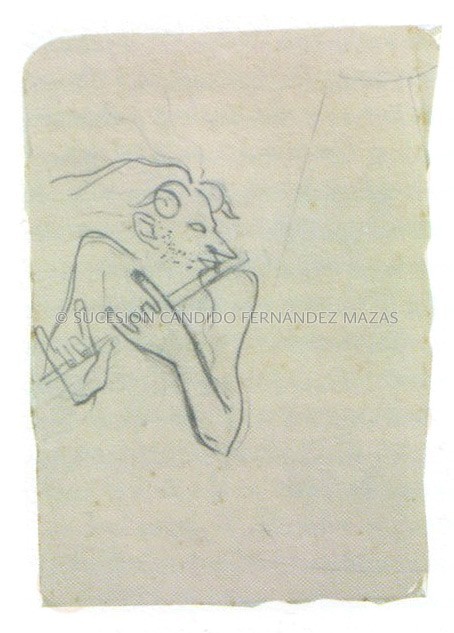
Frame these premises start their tests Velazquez, Goya and Greco (respectively in the numbers 4, 5 and 6 P.A.N.)In which even proposes two guides ordinates of successes and failures, with tags that value the pictures as minimum, undecided, barbarians, artisans copies, Etc., and are well aware that the color values and its internal grammar. Regarding Velázquez was notable controversy with Ramón Gaya. Fernández Mazas had censored stage Drunkards, The Forge of Vulcan and garden view "Villa Medicis”…,14 juxtaposing their meager accomplishments that in his opinion protrude from Las Lanzas, The Spinners, Las Meninas... and those portraits, yielding to the magic of painting, had limited the reality that for some time Velázquez and aspire not catch: the Mariana and Margaret of Austria, Philip IV, Prince Baltasar Carlos or Fernndo of Austria.15 What was most annoying to the sensitivity of our author in works like The drunks It was "chimeric obsession convert painting life of transmuting impossible values" (p. 61); against which the interest of the series as superior values lie in the renewal that It gives the illusion of reality and life, suspended or even eliminated all accidental load. In the process highlights everything struggle, discipline, asceticism. All this was observed with great clarity by Carlos Gurméndez (1981: 42-44).
We see that even considering all the ups and downs of various kinds experienced by Mazas between 1923 and 1935, it remains an organizer aesthetic axis both theoretical thought and his art, graphic, literary and theatrical production. This axis still appears on the roles of "Ars Moriendi" last texts of aesthetic theory of the author, written in the early forties and rescued by his brother Armando in The aesthetics of Fernández Mazas (pp.131-134).
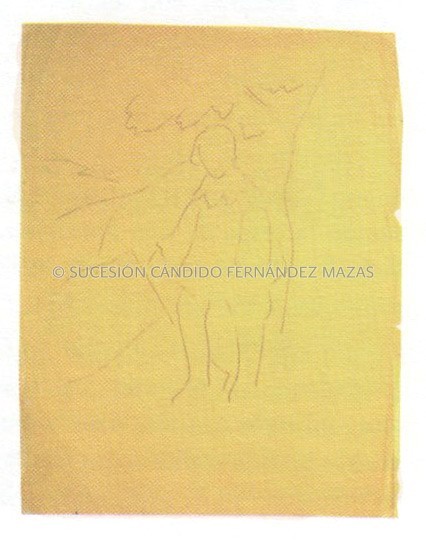
En esquema, se trata de la preeminencia de un vector formal-estructural que actúa en detrimento del aporte semántico-temático; de ahí las convergencias vistas con fenomenólogos y gestaltistas. Interpretada de ese modo, tal axialidad esencialista y lógico-sintética podría conducirnos a pensar la obra de Mazas como un ejemplo entre otros de estéticas puristas. Pero conviene estar advertidos sobre la dimensión lírico-metafísica, si se quiere ontológica y hermenéutica (por intencional), indicada por Dieste: no todo se reduce a categorías, medidas, y correspondencias (ahí se habría excedido Gaya). La estética y la poética del autor ourensano, y aquí hay un trazo compartido con el grupo de the new ones, Not a morfosintaxis line or ciñena situation. Support and demand sense, since perception. They are linked to the achievement of aletheia, of an appearance of truth, I must reiterate that takes explicit presence almost always hand myth as philosofia perennis.
***
Studying the socio-cultural dynamics of the groups involved in the Galician literary system of the twenties and thirties, and start looking into the spatial landscape of lyrical prewar can speak of four main business units: the formed environment We y a Nosa Terra (Nationalist Manuel Antonio as the main reference), the chartered from the spirit of the Seminary of Estudos Galegos (culturalist as Bouza-Brey as a model) generated from professional relationships and friendships in newspapers Galicia and especially The Pueblo Gallego -where would Mazas- and finally which revolved around Cunqueiro and Lyric offices Eastern GalicianThe only of the four-restricted to the thirties intervention. Lines crosslinking ideology, sociological, aesthetic and literary these four units generational16 They are, in any case thick and dense.

As suggested, the unit centered on the editorial board The Pueblo Gallego and close to this medium collaborators had an ideology not opted in favor of nationalism. And the same thing happened with a (sub) rather than generational unit can add to the previous four, although at another level, even in the relative subordination of The Pueblo Gallego. It is what formed the group lugués Estela, At times concomitant with the spirit that is located in Literary GazettePredisposed to play a difficult role crimping and dialogue between the draft AlfarThe pioneering and adventure Iberianist propounded by Giménez Caballero, pronacionalistas different trends and a line of poets core The Pueblo Gallego (Correa Calderon and co-promoter EstelaAlthough he never published there).17 Poets integrated into the generation unit The Pueblo Gallego Luis Amado Carballo are, Roberto Blanco Torres, Eugenio Montes, Angel Sevillano, Julius Siguenza, Juan Jesus Gonzalez, Valentin Peace Andrade, Rafael Dieste, Joseph Otero Espasandín Cándido Fernández Mazas and Johan Carballeira. The five last published in a book of poems in Gallego before the civil war.18 Despite which, Mazas, for example, appeared on the valuable Galician poetry anthology (1928) Alvaro de las Casas, being usual attention to his poetry in critical scenarios outlined in the thirties by several analysts.
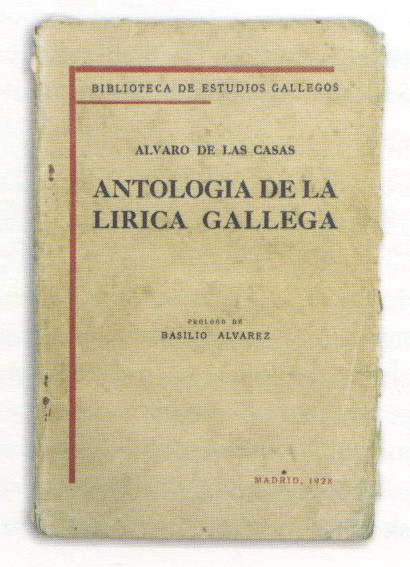
You can not say that the core of poets linked to The Pueblo Gallego share a specific poetic, but it was remarkable predicament hylozoism or imaginismo Amado Carballo, poet influenced by symbolism and creationism. Some notes identifying the imaginismo are present in the Galician poems of Mazas, all dated in 1927 and signed with the pseudonym Denys Fernandes. We locate Impressionism eclógico which he spoke Arcadio Lopez-Casanova, with staging of moments from the natural world and / or tasks related to traditional culture, described by displacement adjective and various contagions sensory order (color, kinesthetic, auditory ...) Animism Mazas is not as intense as that became common in the poets who followed the pattern of Amado Carballo, but his references to wind or the Terra (metonimia por Galicia) concurren a la línea antropomorfizadora dl mundo natural –prosopopeya en fin– que los hilozoístas reflejaron casi sismpre en movimiento, razón que explica el alto rendimiento de la metáfora verbal. Mazas, dibujante de quietudes y reposos, contrasta en parte con esa tendencia, que en rigor sigue sólo en el poema “Alalás”, el único en el que comparece otro de los rasgos peculiares de la poética imaginista, la reducción del sujeto enunciador a una especie de testigo externo, sin implicación directa o inmediata con lo que su discurso presenta. En “Alalás” el yo poético pone de manifiesto la locura del viento en dos escenarios distintos, la tierra y el mar. En ambos marcos, eñ viento aparece fuera de lugar, en soledad:
Alala lean LAND:
On the street of the earth
vento of sugar cane, salaia.
THE SEA Alalá Abra:
On the street of the sea
The crazy wind sobbed.
Alala WIND slim:
_For sea and the land
or wind tolo, en exile!19
The rest of poems is constituted, on the contrary, on sharp apostrophes that target or a you singled out (there are two poems in which the poetic recipient is a young woman mozuela Mazas many times present in the The girl Traditional literature) or to a you almost always determined by a condition of community. The latter case, they appear influences of poets like Eduardo Pondal and Curros Enríquez, noticeable in the two texts dimension civilIf we mean well, but also come to a moral tone, a bit like Roberto Blanco Torres. It is "Aleteia" and "Oo Galego awakening".
However, the most obvious feature in the poetic corpus of Mazas lies in its assumption of the popular-rhythmic metric, manifest in the title patterns and architecture of the poem we have just seen, or, clearly, in the presence of verse octosílabo . This is only disinherited in favor of the Alexandrian n the poem AleteiaWhich dedicated to Eugenio Montes20 y tiene como lema el apotegma de Platón el hombre es la medida de todas las cosas. La propensión popularista hay que verla, de todos modos, en un marco de mayor amplitud, el que se corresponde con el neotrovadorismo, corriente poética de largo aliento en la literatura gallega a partir de los años veinte. Tal etiqueta agrupa las manifestaciones textuales que contemplaron como modelo la obra de los trovadores gallego-portugueses medievales, en especial en lo que afecta a opciones de carácter métrico, retórico, temático, léxico o genológico.
Si bien poetas como Álvaro Cunqueiro introdujeron sobre estas pautas, no antes de los años treinta, determinados quiebros vanguardistas –hay críticos que hablan incluso de surrealismo–, lo cierto es que en Mazas no se aprecian marcas de ruptura. Sus juegos de innovación afectan apenas al ámbito combinativo o sintáctico. Como es habitual en el neotrovadorismo, la pauta rítmica está inducida por el paralelismo y otros fenómenos de repetición, entre ellos variaciones sobre broken, mordobres, Sayings, etc. Mallets used particularly the verse of three lines with odd rhyme, and favored little saying, only present in "Abride to Xanela Oomar" poem which resonate several echoes Amado Carballo and also some marine medieval:
Abrid window oo March
asures that salty winds
By ila have to enter.
MINE seaside home,
My love veiramar!
Abrid window oo March
how far the boat has ruges
and my good has arrived.
MINE seaside home,
My love veiramar!
Abrid window oo sea!
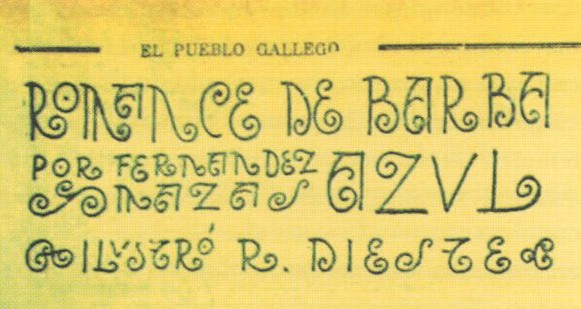
De signo bastante diferente es el poema en castellano “Romance de Barba Azul”, publicado por ves primera en El Pueblo Gallego el 25 de Julio de 1929. Comparte con el resto de la poesía de Mazas únicamente el metro tradicional octosílabo y la recreación del lenguaje popular. Pero es notablemente más largo y tiene carácter narrativo, complementado con prosas en el inicio y el final. Incluso se permite la introducción de neologismos y de contrapuntos discursivos limítrofes con las poéticas de las vanguardias: lunas apierrotadas, el kodak… El poeta reelabora la leyenda de Barba Azul, introduciendo a mayores el tópico de los celos por la presencia de un trovador que rima versos de amor mientras el caballero se ocupa en guerras. El imaginario de fondo y el entramado simbólico se compadecen aquí con los que son propios de los dramas y los relatos del autor, desde luego mucho más claramente que en la producción en gallego. El mitema de base no es otro que el de la inocencia, en el romance corporeizada en Margorí (linda zagala), asediada y vencida por la perversión del señor feudal. La pureza ante el mal, también el candor juvenil y la soledad frente a la experiencia mundana y el poder, sobre todo el poder: “I besará tu amapola – oh, tu amapola incendiada!/ y el lino de tu melena, y tus majillas rociadas”. Pero la perversión de Barba Azul trasciende a la que se pueda atribuir a don Juan, porque su signo va más allá de la seducción; lo es también de tortura y de muerte, que recae –y esto es reiterativo en Mazas– sobre una mujer distinta y sola: la moza isolada, lozana, activa, sabia, quizás loca y pasional que tantas veces aparece en sus ficciones. Margorí se casará con Barba Azul porque su misterio de odio, castillo y sangre anima tentaciones irresistibles en su imaginación. Tiempo después entregará su amor a un hombre joven, un trovador. No es difícil establecer correspondencias con la “parábola en tres escenarios” Santa Margorí, Written almost simultaneously with the romance but, naturally by the dimensiónd itself and the part, much richer in perspectives and nuances. Around all these obsessive images of the author it is what psychology and Charles Mauron stand out as if personal mythWhere there is a space for fun / fake sonsunción or for the actual destruction of self-male who enunciates with or without suffering / death of the woman. It is so glaringly in the following poem, where the verb Muin [Grind] with cyclic and friendly euphony which means pan O existence, It has associated the negative sema of grief and tragic annihilation (of the word, love ... life):
Much teas Muin:
mill cute muiñeira
Kansi to your Kantar.
Muin foolish Ondine:
mill glad muiñeira
the more my outas kansiós.
Muiña or pollen Lwa:
mill blonde muiñeira
the more your sura Kansi.
Windmill for flos your kor,
the machine iauga i the wind
and my love simpler.
And it looks even better, perfectly nominal figure, in the name that receives one of the female characters The legend of Don Juan. Comedy 400. I speak, of course, the girl Barbantes,21 beautiful girl of fifteen, always laughing, but "impenetrable eyes, cruel, consabidos" (p.126)
It should not be surprising that poetry written by Fernández Mazas, with its penchant for adapting still forms medievalizantes, de estructura rítmico-métrica muy definida y de innegable vocación sintético-esencialista, como toda lírica que bebe en el popularismo– recorriese los rumbos descritos. Los mitos y también los motivos de adscripción folclórica, como el encuentro con la moza convidada a ir de fiesta en el poema “O pano bermello campa”, detienen el momento y lo llenan de fuerza emblemática de los arquetipos. Su funcionalidad se orienta siempre a la consecución de una verdad simbólica, bien de validez restringida a la etnia o bien de extensión universal. Mazas optó casi siempre por la segunda vía.
I will not refer at length to short stories published between 1922-1930. In the writings in Spanish there are rumors surreal, that no longer appear in the writings in Galician few years later. These move either in the direction to open Dieste From the archives of naughty and Castelao with thingsBooks of 1926. We focus here on older narrative texts, integrated in An unfinished novel, Added chapters that between April and October 1933 were coming in School Work. In the "Afterword" to his edition of the work (p.157), Armando Fernández Mazas suggests that these chapters could be considered episodes already developed -in other direction, background- a comprehensive project l also enter "The Revolution of Babelinas" and "The Forgotten de la Rua del Sol". For all that together have provided the author's name Dominion Lands novel. Back in Casas do Penedo, in early 1940, had begun ajuntar notes and tokens which, ordered by his brother Armando fifty years later, are today the conglomerate we know as A novel Inacabada. Obviously this arrangement no longer a proposal. Well-intentioned and thoughtful, but only a proposal, which also works with fragmentary, unfinished and sketch, "notes scattered without ilación or established relationship" elements, as acknowledged by the editor itself (p.47).
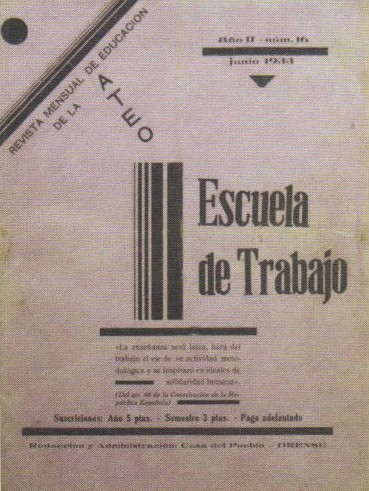
Pedagogical magazine cover School Work (Ourense, 1933)
No carece de interés, por otra parte, la información sobre las circunstancias que promovieron la escritura d ese material narrativo. Se explica en el prólogo con precisión. En la casa de Castro Caldelas había aparecido el Libro Tumbo de la Abadía de San Paio de Abeleda, fechado a comienzos del siglo XVII. Al margen de ello, Mazas había estudiado el manifiesto A los renteros de San Paio de Abeleda, redactado dos siglos y medio después. Pues bien, según el editor y prologuista, esos dos textos fueron determinants para que Cándido tomara la decisión de escribir una novela. En ella se iban a coordinar dos partes. La inicial –“La Revolución de las Babelinas”– debería atender a la vida de los gallegos en la emigración, con especial atención a su organización en soiedades secretas, masónicas, neosóficas, esotéricas… El segundo–“Los olvidados de la Rúa del Sol”– se ceñiría a la vida de los hidalgos y labradores fedatarios en Galicia (p.44).
Sabemos poco de las lecturas de Mazas en materia de narrativa. Pese a conservarse una parte de su biblioteca y a que tenemos algún dato sobre sus regresos constantes a la narrativa de Balzac, memorizada y recitada en veladas familiares, lo ignoramos casi todo sobre sus opiniones críticas en relación con la narrativa de su tiempo. La presencia de novelas de John Galsworthy y de Leonid Andréiev entre sus libros sugieren intereses sociales de los que ya nos informa la propia biografía. Su hermano Armando asegura en el “Prólogo” a An unfinished novel (P.42) that "Candide knew well" the paths of the French novel of the XIX. Theater and narrative Valle-Inclan should also occupy a special place of preference. This is confirmed by the style and rhythm of your writing, or the kind of worlds for it propitiated. It is a shared admiration for the entire group P.A.N., since the magazine promoted a campaign for the Nobel prize to the author of the Barbaric comedies. There is an unpublished letter of Eduardo Dieste his brother Rafael, then in Antwerp, which introduces nothing banal consideration. The date corresponds to January 24, 1935:
Es necesario que tú hagas y nos mandes por avión una cuartilla lozana exaltando a don Ramón del Valle Inclán como nuestro candidato al premio Nobel. Se la habría encargado a Mazas, pero éste –dice– no puede hacerla sin meterse con la España negra, y –digo yo– esto no puede hacerse sin el consentimiento de Valle (actualmente en un sanatorio gallego); por otra parte conviene dar a la candidatura la viabilidad posible, no hemos de ser los primeros en entorpecerla, aunque descontentos que no triunfe22.
The first thing the reader sees in the chapters School Work es el esmero eurítmico y la eufonía de la prosa. Es una escritura de decantada propensión descriptiva, estampas muy plásticas, con una nada reprimida entrada en galicismos y arcaísmos léxicos y sintácticos, y con acceso franco a la música primitiva de topónimos y antropónimos. Prosa para leer en voz alta, demorándose en las enumeraciones y en las topografías, en el salmo pánico del fraseo, en el aire de leyenda contada. También los nombres y las figuras de los animales son poemas mínimos. La lengua tira a grave a veces, otras se hace grotesca en busca de juegos rítmicos aliterativos, igual que en el esperpento valleinclanesco:
Pingorotudo en el regalo de la sombra, floreaba benjamín el tintorero. A su lado, un negado, el Ilotas del Pindo, le tocaba el caramillo a un gallo capón sobre una pata y reía el Ilotas su caótico interior (p.132).
El rapaz Xuanín de Drados permanece en segundo plano, como un destinatario mudo de la activación de los recuerdos de otros, en especial los de Juan Pelerín. En el conjunto del discurso narrativo la voz de Xuanín se instituye como la del narrador principal, pero cede especio a perspectivas ajenas, incluso aun narrador en tercera persona que en algún momento impone su presencia por pura necesidad diegética. Los hechos acontecen en un tiempo que no se quiere determinar con exactitud; ciertas costumbres –así, las presentadas bajo el epígrafe “Feria y antruejos de la villa”– tienen sabor medieval, otras prácticas serían localizables en el siglo XIX o a comienzos del XX; cabría hablar, pues, de una temporalidad panhistórica en la que se singularizan acontecimientos representativos de unas relaciones económicas y sociales casi invariables. Claro que se introducen asimismo contrapuntos para una filiación histórica más precisa. Un caso es el del mendigo que pide ayuda amparándose en su condición de superviviente de la batalla de Cavite (Filipinas, 1898)23.
Xuanín accompanies Juan Pelerin, mysterious and reserved man, who still greets people Captain for its legendary past:
He preferred to live among wolves. Soon the men knew it. He gave him the evil high and stole the money. He sowed terror in lands of Miño and lavished the stolen between poor as well. Dread curiales and madreabadesas, Juan Pelerin, as the world was called, did justice into their own hands ....
Protegiéronle always those of Drados; and when the civilero harassment will not let him live, there he retired (p.140).
Pelerín cuenta con el respeto y el afecto de sus vecinos pero también con el odio de los oligarcas y de los poderes instalados en la villa, que quieren su muerte. Con el niño Xuanín baja a la villa desde las tierras montesinas de Drados una vez por trimestre para pagar los foros del corregidor, un oprobio insoportable para los vecinos del lugar que manifiestan un ánimo colectivo en el límite exacto de la revuelta. Este es el telón de fondo, que el relato traza en los dos primeros capítulos con una poética narrativa extraordinariamente económica, de maneras cinematográficas. A partir del tercer capítulo, “En otros tiempos no era así”, se accede a una serie de recuperaciones del pasado por vía de las confidencias del hombre al chico (“¿Tú me entiendes, Xuanín de Drados”?, p.136): la infancia difícil de Pelerín, el amor de primera juventud ytruncado por imposiciones paternas y por la muerte temprana de la muchacha –Alanda–, después profanada en la tumba por el sepulturero de Alais, Pancho Cuchillos. Todo esto aparece contado en esencia, de nuevo en un esquema nada profuso en detalles. En los capítulos finales de la serie el diálogo es el elemento discursivo que sostiene toda la funcionalidad informativa. Aporta datos concretos y contribuye a acelerar el ritmo narrativo en una segmentación también ágil y esencial. La muerte acecha a Pelerín, pero la gente interviene y lo ampara.
Armando Fernández Mazas reveals that Candide stopped deliveries to School Work en el mes de octubre de 1933 por la llegada a Ourense del Grupo de Misiones Pedagógicas que recorría Galicia desde agosto. La lectura de los capítulos publicados – su disposición y ritmo internos, la arquitectura proyectada que entrevemos, la lógica narrativa– permite conjeturar que el relato no iba a ser mucho más largo, que las entregas futuras estaban contadas. Así las cosas, no resulta fácil compartir las hipótesis del editor del volumen An unfinished novel on the internal bonding of the three series compiled. Activated poetic narrative to tell the story of Juan Pelerin is concurrent with the aesthetic positions before you reviewed. The life of this rebellious and unfortunate man, marked by fate, is marked by many episodes that usually would be classified as novelistic, since its origin (single mother, Father Abbot). But as always Mazas, an aspiration was imposed to offer cipher a reality, prescindiendo por tanto de la acumulación de información superflua; como él mismo diría: sin trasladar a la literatura la representación toda de la vida. Tenemos así un escorzo aleteico del signo vital de Pelerín, una síntesis despojada de accidentes, en la que los acontecimientos son los mínimos para la generación del mito; en definitiva, para la resolución de un conflicto de dimensión moral sin sobrecarga realista. De ahí el entendimiento extraordinario de las elipsis, de los silencios y de los vacíos. De lo que no está, de lo elidido. De lo que no se dice y/o no se sabe. Todo lo cual encaja parcialmente en ese marco difuso que conocemos como lyrical novel, Who joined the Spanish literature of those years proposed very different between intellectualism and humor or between psychologism and dehumanization-from Antonio Espina Benjamin Jarnés from Mario Verdaguer John Chabás-.
The behavior of the other two series integrated An unfinished novel es diferente. Si bien parece aceptable que haya poco en ellas sin presencia en los textos de preguerra –incluida la fabulación onírica, un intimismo durativo de ascendente bergsoniano o las redes entre autobiografía, historia )(Inés de Castro, Disraeli, Gandhi, Sacco y Canzetti…) y metaficción–, lo cierto es que “La Revoluciónde las Babelinas” y “Los olvidados de la Rúa del Sol” potencian notablemente algunas características antes subordinadas, que por momentos aproximan a Mazas al genio fabulador del Álvaro Cunqueiro de la postguerra y a ciertos ambientes recreados por Vicente Risco en su etapa neosófica. La reiterada advertencia sobre la naturaleza de estos papeles fragmentarios, de esos materiales sin elaboración culminada, de estos documentos para una escritura ulterior, vuelve a cobrar pertinencia.
"The Revolution of the Babelinas" begins by presenting minimum portraits of characters or lines. In some cases an ideal of life, and this corresponds to the Fernández Miranda family to the early nineteenth century guess:
Florentina delicacy, provencal ways, Hellenic wisdom, spartan accommodation, war urgings, soft joys, doubts and resignations: Catalan roses in galaicas fogs; that give the coordinates of these herrumbrosos surnames. Inside, of course, a wise tradition, not of blood (p.52).
There is also an outline of plot, which has to do with the Tumbo book citado y con la redención de foros. El arcipreste Miguel Calaprís vividor y cínico, es cesado en su puesto por el Obispo, tras lo cual acude a París para ttratar de localizar a Juan Fernández Miranda, a quien sabe en posesión del Libro Tumbo de Santa Belida de Veira Alta y de las ciento setenta y siete cartas forales que interesa recuperar a la Casa de Alba. Tras muchas vicisitudes, Calaprís encuentra finalmente a Miranda en las islas Babelinas, donde residía con Lady Helene Stuart. A partir de ahí los materiales narrativos constituyen lo que en algún momento se presenta como un “elogio sentimental de toda bohemia”, entendida esta como la vida de los que agotaron las ilusiones (pp. 68-69), como un “bergsoniano fluir [que] nos lleva fatalmente al suicidio” (p.85). Vida cosmopolita y decadente de quien frecuenta sociedades secretas, museos de cera y algún ateneo anarquista, de quien alterna con rotarios, filántropos, agentes secretos, esperantistas, teósofos…., en un entrecruzamiento de tiempos y de espacios –como cuando se dice “Juan Fernández Miranda, natural de Éfeso, en el dionisíaco Bajo Miño” (p.67).
“The forgotten ones of the Rúa del Sol” unfolds a plot even to a lesser extent. The representation of animal life increases and the line of death appears in the foreground. Express mention is made of Hesiod and Horace, of the work and the days in retired life. But in parallel, the "peasant fox" (p.102) enters, animalized, with grotesque deformation and unusual introduction of corporeal references, again close to the grotesque:
Maria Laurencia with a lighted candle entrusts the soul of Cuquiño. Inveria. At the foot of the bed the old wineskin of a goat. Baby, Cuquiño, baby! The clerk and Maria Laurencia inheritance is distributed. Witnesses said the rapabarbas of Portela and Fornelos piper. A Touza of Laberca, or Val da Urraca, or Souto de Portugal and silver candlesticks. sleazy, unsociable, Cuquiño is softened and lost consciousness at the praise, and gave it everything. Baby, Cuquiño, baby! Like the grandmother Carmen.
[…]
Rufus of Tor…. Semantics of sophists: Death. Three days in the mortuary box, among axes, dressed in carnival finery, mask. His defecation and death on the third day. Elizabeth Quiroga her barragana, crazy, gone, in the Wax Museum watching the days go by. The Samaritan Woman (pp. 102-103) and 112-113)
It is not easy to calculate the paths that Cándido Fernández Mazas would have followed as a narrator to overcome the hard final years of his life and the presence of war, defeat and illness. Reading some texts like the previous ones, there will be those who think of a reunion with the realist tradition, in an anticipation of the existential novel... It is advisable not to focus only on language, but it is not ruled out that it was so. That in the categorical synthesis that always characterized his attitudes towards art, after the experience of failure and the death of so many, he sought new myths with which to offer the truth of a dark time. I do not know if on the other side of nihilism.
NOTES
1 Santa Margorí (Madrid, Alcor Galaico, 1930) was the only work published in his lifetime. In 1931 he wrote between Ourense and Madrid The crazy horns. Farce seven timesWhich in 1981 it was incorporated into the joint edition Santa Margorí. The crazy horns.(Sada, Ediciós do Castro, 199-277) and had a later edition prepared Armando Fernández Mazas pro (Ourense, Andoriña Editions, 1993). A third piece, incompletely preserved is the legend of Don Juan. Comedy 400) written in 1932 and published also by the author's brother and under the same publishing house in 1994.
2 Basically it is collected in a volume Armando Fernández Mazas care, journalism Fernández Mazas, 1990, Ediciones Andoriña. Carlos Gurméndez had collected in 1981 much of the critical-essayistic production of his friend in a "Anthology of short texts" incorporated into the book Cándido Fernández Mazas. His life and work (pp45-110).
3 Between April and October 1933 published in Labor School, organ of the Association of Education Workers of Ourense (ATHEIST, framed in the UGT) Six narrative chapters Armando Fernández Mazas linked to An unfinished novel, Edited by himself, again in Andoriña, in 1995 (these six chapters are located on pages 121-155;. In 1981 had already appeared on pages 65-73 of. Cándido Fernández Mazas. His life and his work, Carlos Gurméndez). These texts are presented in fact as the only culminated a work in progress I would have started months before incorporating Cándido the -efectiva Pedagogical Missions in December 1933 and returned to the author in his last three years, in the removal of Castro Caldelas. In the edition which we owe to his brother, An unfinished novel It consists of two parts, entitled "The Revolution Babelinas"(Pp.49-95) and"The forgotten de la Rua del Sol"(Pp.97-119). We also have other very short stories Armando Fernández Mazas ordered in the sector "poetic journalism"Of his book Fernández Mazas journalism. I refer specifically to those that appear on pp. 17-23 ( "Cane man”, “Seafood house" Y "Alcohol flame Anton Mariño"; taken from newspapers The Zarpa Y Galicia and for the period 1922-1925) and pp.40-42 ( "30F" and "Gorigori do tempo" both in Galician, correspond to the magazine WeWhere they appeared in numbers 25 and 79 of June 25, 1926 and July 25, 1930, respectively).
4 The lyrical corpus in Galician, six poems, appears also compiled in the book of Armando Fernández Mazas Aesthetics Fernández Mazas (Pp.136 and 149-155), volume care of Teresa lopez Sowing stelae. five poets the forefront. (Pp.71-78). French poetic prose can be read in Paris Drawings 1925-1927 (Pp. 36-38). This is a poorly defined literary form that Mazas continued to practice soon after in Spanish in the newspaper He Pueblo Gallego, As seen for example reading "Penina watching the earth" or "the landscape, and then Pachón" (2 and 9 August 1928, collected in "Fernández Mazas journalism" (49-50 and 53- 54). also in Castilian, count "The Romance Bluebeard" (in Fernández Mazas journalism, Pp. 97-100) and finally the verses that are integrated into song mode at two Santa Margorí (Of particular interest is the "Song of the Bacchae hidden", p.42 in the facsimile editions of Castro).
5 In the P. 15 incorporated into the semblance volume Paris Drawings 1925-1927. On the other writing mentioned by Armando Fernández Mazas in his "Introduction to Don Juan legend (P.56), we know that friends were Otero Espasandín and Rafael Dieste.
6 It begins: "This murky desire of the winding, twisted than that acienaga to Galicia in all its exhibits, leads the field of thought filled his baroque style. One could say that in Galicia there is nothing clear, synthetic, orderly "(see the book Fernández Mazas journalism, Pp.70-71). The author differentiates on that basis two groups of critical thinkers. One would be to the followers of the romantic Ethnicism Murguia, who despises Mazas. The other would be a rationalist lineage, constituting Feijoo, its main reference. also points to some followers: Said Armesto, Viqueira, Valle-Inclan, Blanco Torres, Antón Villar Ponte, Jacinto Santiago, Rafael Dieste and Eugenio Montes.
7 See Becerra Suárez (1997) and Perez Bustamante (1998).
8 Anyway, Trotsky had formulated in his essay Literature and Revolution that being the revolutionary process also an attempt recovery of popular culture, that did not mean the sacrifice of the art of teaching non-propagandistic condition nor the renunciation of lyric poetry understood in the traditional sense (Trotsky 1973: 50-126).
9 I quote by César Antonio Molina (1989: 676).
10 The last four names mentioned are for people who would be killed by the fascists in the early months of terror which underwent Galicia after the military uprising of July 1936.
11 Many of these texts receive annotation and commentary on the book Aesthetics Fernández Mazas, 1992.
12 The reduction can be understood in an alternative direction, which is resulting in what Husserl called transcendental phenomenological reductionMuch more relevant from a philosophical and aesthetic. Now is not a reduction but a redirect without a return to the original things. For Husserl, the reality is the experience of reality. That is the refocusing that operates the transcendental reduction: reality as a correlate of consciousness.
13 And, of course, the graphic humor practiced in various ways and circumstances: in the newspaper agrarista-yo Republican The Zarpa (1925-1926), the organ of the Republican Left Politics (1935) and during the civil war in Trotskyists Red Fighter Y POUM. See volume compilation of Armando Fernández Mazas humor graphic Fernández Mazas (Dichi) (1989). Insert Chaplain (1991) and Bouzas (1998).
14 The latter work is not clear who belongs to the same years as the previous two. Some scholars move to the Velázquez second trip to Italy, between 1649 and 1651.
15 In the interest of the considerations made by Ramón Gaya in reply to Praise and censure of Diego Velázquez, Writing P.A.N. He decided to incorporate his letter in the seventh installment of July (pp.140-141). It accused the Gaya excesses of the rationalist Mazas talent, his boundless faith in the location -forever and for all- a set of weights and measures also apply to the arts.
16 Employment concept generational unit in the sense explained by Karl Manheim "The problem of Generationem "Cologne Quarterly Journal of Sociology7, 1928 (no French translation: The problem of generations, Paris, Nathan, 1990). Generational units are the specific groups under a certain situation manifest related reactions, social, cultural ... historical events Regardless of the age of its members, the generating units cohere from some intentions basis for act on the real situation in enrolling.
17 Estela It is also a character Santa Margorí, precisely the man who visits Sor Margorí in the Marianelas convent, a new variant on the theme of Don Juan. They had lived a love in adolescence, never forgotten. It is not ruled out that in some features of Ronsel's speech the author wanted to hide the vital attitude and the problems of social adaptation of the homonymous group, perhaps of himself. Some notes are quite explicit in this regard, once again of interest for a possible psychocritical approach. An example: “Ronsel is one of those boys who have made the world's pain his own, who will give nothing to life that denies them everything. One of those boys for whom the experience is nothing more than the affirmation of the theory, painfully lived. One of those tormented boys who search for the most affectionate reality in the universe.[/] One of those beings whose life ends among primitive people, forgotten by Europe, on the shore of a lake” (pp.68-69).
18 And after the war, only five Paz Andrade published books of poems in Galician.
19 I will quote the poems by Teresa Lopez indicated edition, Spiral Maior. Therefore I will respect morphology, spelling and punctuation used by the author and not always consistent. Particularly on this most curious fact is the use of the poem "Moito tes of muiñar" phonetic spelling defended by Aurelio Ribalta. All poems, including "Bluebeard Romance", written in Castilian, initially appeared in The Pueblo Gallego.
20 There are three other poems dedicated. Amado Carballo recipients were Rafael Dieste and Felipe Fernández-Armesto (who, as a journalist, would make famous the pseudonym Augusto Assia).
21 Barbantes It is the Galician name religious mantis.
22 Dieste in the file. Finally, the requested collaboration Eduardo Dieste appeared at number 3 P.A.N. (March 1935, pp.45-46) as a letter to the editor of the magazine.

